Canadian Energy Centre
Indigenous leaders meet G7 diplomats to make case for Canadian LNG
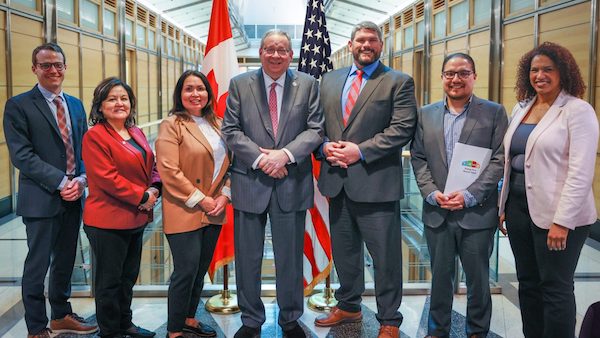
Indigenous leaders meet with U.S. ambassador to Canada David Cohen. Photo courtesy Energy for a Secure Future
From Shawn Logan of the Canadian Energy Centre Ltd.
‘Every official had a real desire to really understand Indigenous sentiment around resource development’
As G7 leaders left Hiroshima, Japan last month, they made a significant admission that liquefied natural gas (LNG) is a critical fuel to help reduce dependence on Russian energy, and that increased natural gas investment is important.
“In this context, we stress the important role that increased deliveries of LNG can play and acknowledge that investment in the sector can be appropriate in response to the current crisis and to address potential gas market shortfalls provoked by the crisis,” wrote the G7 in their final communique last week.
The decision comes just weeks after a small group of Indigenous leaders went to Ottawa to meet face-to-face with diplomats from some of the world’s top economies, convened by Energy for a Secure Future.
Their message to the world was simple: Indigenous communities in Canada can and should be partners at the table when it comes to developing and sharing our country’s vast natural resources. And it may have resonated.
For John Desjarlais, executive director of the Indigenous Resource Network, the vote of confidence for LNG is music to his ears.
“I’d like to think that we were heard – we met with some pretty influential people and heard some of the right things,” he said.
“For them to make that commitment is a big deal, and certainly a difference from some of the early indicators before the G7.”

Tapped earlier this year as the new executive director of the Indigenous Resource Network, Desjarlais found himself in Ottawa with other Indigenous leaders in April, meeting with diplomatic representatives from Canada’s G7 partners – Germany, France, Japan and the United States – as well as delegations from Poland and India.
Desjarlais said he was surprised just how open diplomats were to the notion that Indigenous communities in Canada can be key players in the global energy marketplace.
“What a whirlwind. It was inspiring, especially speaking with the ambassadors,” Desjarlais said of the two-day diplomatic blitz that both challenged perceptions and paved a path for Indigenous voices to play a greater role on the international stage.
“Every official had a real desire to really understand Indigenous sentiment around resource development. There was a sincere desire to learn from our perspective.”
First Nations and Metis have emerged as key partners in Canadian resource projects, particularly the country’s nascent LNG industry.
Global demand for reliable and responsibly produced LNG has continued to grow, with Russia’s invasion of Ukraine last year thrusting it into even greater prominence. The leaders of Canada’s G7 partners Germany and Japan both came to Canada last year to make direct appeals for more Canadian LNG – they left with no firm commitments.

Desjarlais and a group of fellow Indigenous leaders who are on the advisory council for Energy for a Secure Future – a non-partisan coalition of business, labour and Indigenous representatives – outlined their vision for how Canada and First Nations can help be a solution in the drive for increased global energy security, while also helping lower emissions by providing a cleaner alternative to coal.
Crystal Smith, chief councillor of the Haisla Nation on B.C.’s coast, said the first step is dispelling the notion that Indigenous people oppose resource development in Canada.
“When Europeans, Asians and Americans think of Canada’s Indigenous peoples, they often think we oppose all energy development,” she said during a press conference to mark April’s diplomatic meetings.
“We aren’t victims of development. Increasingly we are partners and even owners in major projects.”
The Haisla Nation has a 50 per cent ownership stake in the proposed $3-billion Cedar LNG project, which was granted regulatory approval earlier this year, and is expected to begin operations in 2027.
It marks the largest Indigenous-owned infrastructure project in Canadian history, as well as the first Indigenous-owned LNG terminal in the world.

Karen Ogen, CEO of the First Nations LNG Alliance, said it’s projects like Cedar LNG and others currently under development that will not only help Indigenous communities achieve prosperity, but help the global community in the quest for vital energy security.
“LNG development has provided immediate- and medium-termed opportunities to lift thousands of Indigenous people and our communities out of inter-generational poverty,” she said.
“We are determined to develop our resources in a socially and environmentally responsible way. We want to work with Canada and our allies in the G7 to bring urgency to the development and export of Canadian LNG.”
Beyond Cedar LNG, dozens of First Nations and Métis communities have entered into equity ownership agreements in pipelines, LNG facilities and carbon capture and storage projects, among others.
The Ksi Lisims LNG project, a joint venture with the Nisga’a Nation in northern B.C., has been granted a 40-year export licence from the Canada Energy Regulator, while in Atlantic Canada the Miawpukek First Nation is a part-owner of the proposed export project LNG Newfoundland and Labrador.
Large consortiums representing Indigenous communities have also acquired or are looking to acquire stakes in major pipeline projects including Coastal GasLink, Trans Mountain, and several oil sands pipelines.
According to Desjarlais, the Ottawa summit proved to be a fruitful meeting of the minds. He said it could signal a more important role for Indigenous communities both as more equal resource partners in Canada, but on the world stage as well. The group has been asked to meet again in June with U.S. ambassador David Cohen.
“I never thought it would accelerate to this point – it’s accelerating so fast,” he said.
“Ownership is reconciliation. There’s a whole cascade of benefits that come from these projects everywhere.”
Alberta
The case for expanding Canada’s energy exports

From the Canadian Energy Centre
For Canada, the path to a stronger economy — and stronger global influence — runs through energy.
That’s the view of David Detomasi, a professor at the Smith School of Business at Queen’s University.
Detomasi, author of Profits and Power: Navigating the Politics and Geopolitics of Oil, argues that there is a moral case for developing Canada’s energy, both for Canadians and the world.
CEC: What does being an energy superpower mean to you?
DD: It means Canada is strong enough to affect the system as a whole by its choices.
There is something really valuable about Canada’s — and Alberta’s — way of producing carbon energy that goes beyond just the monetary rewards.
CEC: You talk about the moral case for developing Canada’s energy. What do you mean?
DD: I think the default assumption in public rhetoric is that the environmental movement is the only voice speaking for the moral betterment of the world. That needs to be challenged.
That public rhetoric is that the act of cultivating a powerful, effective economic engine is somehow wrong or bad, and that efforts to create wealth are somehow morally tainted.
I think that’s dead wrong. Economic growth is morally good, and we should foster it.
Economic growth generates money, and you can’t do anything you want to do in social expenditures without that engine.
Economic growth is critical to doing all the other things we want to do as Canadians, like having a publicly funded health care system or providing transfer payments to less well-off provinces.
Over the last 10 years, many people in Canada came to equate moral leadership with getting off of oil and gas as quickly as possible. I think that is a mistake, and far too narrow.
Instead, I think moral leadership means you play that game, you play it well, and you do it in our interest, in the Canadian way.
We need a solid base of economic prosperity in this country first, and then we can help others.
CEC: Why is it important to expand Canada’s energy trade?
DD: Canada is, and has always been, a trading nation, because we’ve got a lot of geography and not that many people.
If we don’t trade what we have with the outside world, we aren’t going to be able to develop economically, because we don’t have the internal size and capacity.
Historically, most of that trade has been with the United States. Geography and history mean it will always be our primary trade partner.
But the United States clearly can be an unreliable partner. Free and open trade matters more to Canada than it does to the U.S. Indeed, a big chunk of the American people is skeptical of participating in a global trading system.
As the United States perhaps withdraws from the international trading and investment system, there’s room for Canada to reinforce it in places where we can use our resource advantages to build new, stronger relationships.
One of these is Europe, which still imports a lot of gas. We can also build positive relationships with the enormous emerging markets of China and India, both of whom want and will need enormous supplies of energy for many decades.
I would like to be able to offer partners the alternative option of buying Canadian energy so that they are less reliant on, say, Iranian or Russian energy.
Canada can also maybe eventually help the two billion people in the world currently without energy access.
CEC: What benefits could Canadians gain by becoming an energy superpower?
DD: The first and primary responsibility of our federal government is to look after Canada. At the end of the day, the goal is to improve Canada’s welfare and enhance its sovereignty.
More carbon energy development helps Canada. We have massive debt, an investment crisis and productivity problems that we’ve been talking about forever. Economic and job growth are weak.
Solving these will require profitable and productive industries. We don’t have so many economic strengths in this country that we can voluntarily ignore or constrain one of our biggest industries.
The economic benefits pay for things that make you stronger as a country.
They make you more resilient on the social welfare front and make increasing defence expenditures, which we sorely need, more affordable. It allows us to manage the debt that we’re running up, and supports deals for Canada’s Indigenous peoples.
CEC: Are there specific projects that you advocate for to make Canada an energy superpower?
DD: Canada’s energy needs egress, and getting it out to places other than the United States. That means more transport and port facilities to Canada’s coasts.
We also need domestic energy transport networks. People don’t know this, but a big chunk of Ontario’s oil supply runs through Michigan, posing a latent security risk to Ontario’s energy security.
We need to change the perception that pipelines are evil. There’s a spiderweb of them across the globe, and more are being built.
Building pipelines here, with Canadian technology and know-how, builds our competitiveness and enhances our sovereignty.
Economic growth enhances sovereignty and provides the resources to do other things. We should applaud and encourage it, and the carbon energy sector can lead the way.
Business
Oil tanker traffic surges but spills stay at zero after Trans Mountain Expansion
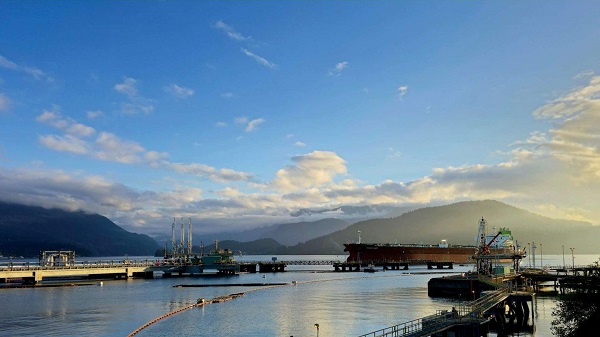
From the Canadian Energy Centre
Bigger project maintains decades-long marine safety record
The Trans Mountain system continues its decades-long record of zero marine spills, even as oil tanker traffic has surged more than 800 per cent since the pipeline’s expansion in May 2024.
The number of tankers calling at Trans Mountain’s Westridge Marine Terminal in the Port of Vancouver in one month now rivals the number that used to go through in one year.
A global trend toward safer tanker operations
Trans Mountain’s safe operations are part of a worldwide trend. Global oil tanker traffic is up, yet spills are down, according to the International Tanker Owners Pollution Federation, a London, UK-based nonprofit that provides data and response support.
Transport Canada reports a 95 per cent drop in ship-source oil spills and spill volumes since the 1970s, driven by stronger ship design, improved response and better regulations.
“Tankers are now designed much more safely. They are double-hulled and compartmentalized to mitigate spills,” said Mike Lowry, spokesperson for the Western Canada Marine Response Corporation (WCMRC).
WCMRC: Ready to protect the West Coast

One of WCMRC’s new response vessels arrives in Barkley Sound. Photo courtesy Western Canada Marine Response Corporation
From eight marine bases including Vancouver and Prince Rupert, WCMRC stands at the ready to protect all 27,000 kilometres of Canada’s western coastline.
Lowry sees the corporation as similar to firefighters — training to respond to an event they hope they never have to see.
In September, it conducted a large-scale training exercise for a worst-case spill scenario. This included the KJ Gardner — Canada’s largest spill response vessel and a part of WCMRC’s fleet since 2024.
“It’s part of the work we do to make sure everybody is trained and prepared to use our assets just in case,” Lowry said.
Expanding capacity for Trans Mountain

The K.J. Gardner is the largest-ever spill response vessel in Canada. Photo courtesy Western Canada Marine Response Corporation
WCMRC’s fleet and capabilities were doubled with a $170-million expansion to support the Trans Mountain project.
Between 2012 and 2024, the company grew from 13 people and $12 million in assets to more than 200 people and $213 million in assets.
“About 80 per cent of our employees are mariners who work as deckhands, captains and marine engineers on our vessels,” Lowry said.
“Most of the incidents we respond to are small marine diesel spills — the last one was a fuel leak from a forest logging vessel near Nanaimo — so we have deployed our fleet in other ways.”
Tanker safety starts with strong rules and local expertise

Tanker loading at the Westridge Marine Terminal in the Port of Vancouver. Photo courtesy Trans Mountain Corporation
Speaking on the ARC Energy Ideas podcast, Trans Mountain CEO Mark Maki said tanker safety starts with strong regulations, including the use of local pilots to guide vessels into the harbour.
“On the Mississippi River, you have Mississippi River pilots because they know how the river behaves. Same thing would apply here in Vancouver Harbour. Tides are strong, so people who are familiar with the harbor and have years and decades of experience are making sure the ships go in and out safely,” Maki said.
“A high standard is applied to any ship that calls, and our facility has to meet very strict requirements. And we have rejected ships, just said, ‘Nope, that one doesn’t fit the bill.’ A ship calling on our facilities is very, very carefully looked at.”
Working with communities to protect sensitive areas
Beyond escorting ships and preparing for spills, WCMRC partners with coastal communities to map sensitive areas that need rapid protection including salmon streams, clam beds and culturally important sites like burial grounds.
“We want to empower communities and nations to be more prepared and involved,” Lowry said.
“They can help us identify and protect the areas that they value or view as sensitive by working with our mapping people to identify those areas in advance. If we know where those are ahead of time, we can develop a protection strategy for them.”
-

 Energy2 days ago
Energy2 days agoTanker ban politics leading to a reckoning for B.C.
-
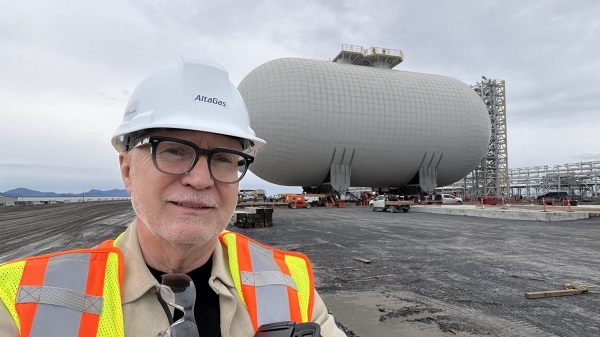
 Energy2 days ago
Energy2 days agoMeet REEF — the massive new export engine Canadians have never heard of
-

 Energy18 hours ago
Energy18 hours agoCanada’s future prosperity runs through the northwest coast
-
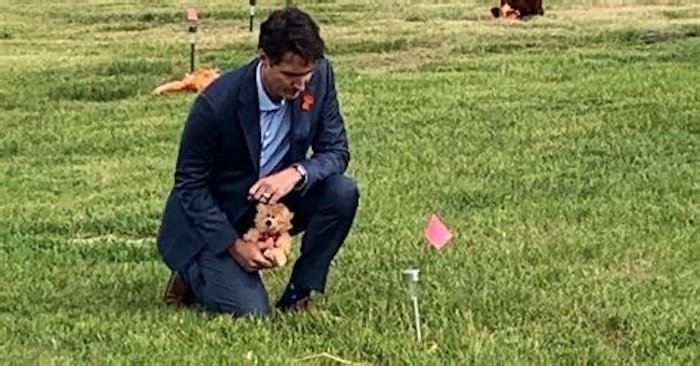
 Fraser Institute2 days ago
Fraser Institute2 days agoClaims about ‘unmarked graves’ don’t withstand scrutiny
-

 Alberta2 days ago
Alberta2 days agoHere’s why city hall should save ‘blanket rezoning’ in Calgary
-

 Business2 days ago
Business2 days agoToo nice to fight, Canada’s vulnerability in the age of authoritarian coercion
-
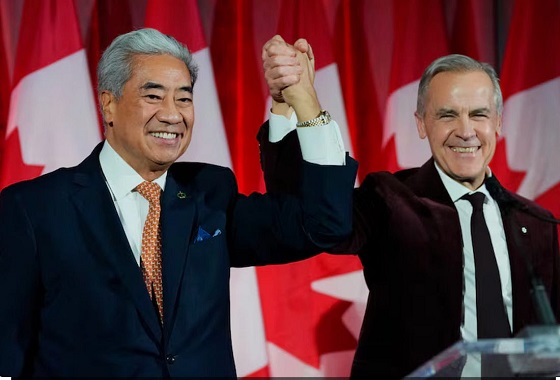
 Fly Straight - John Ivison1 day ago
Fly Straight - John Ivison1 day agoMPs who cross the floor are dishonourable members
-

 Business2 days ago
Business2 days agoUNDRIP now guides all B.C. laws. BC Courts set off an avalanche of investment risk







